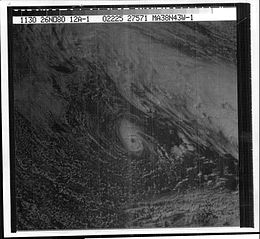Hurricane Karl (1980)
| Category 1 hurricane (SSHWS/NWS) | |

Hurricane Karl on November 26
|
|
| Formed | November 25, 1980 |
|---|---|
| Dissipated | November 29, 1980 |
| (Extratropical after November 28, 1980) | |
| Highest winds |
1-minute sustained: 85 mph (140 km/h) |
| Lowest pressure | 985 mbar (hPa); 29.09 inHg |
| Fatalities | None direct |
| Damage | None |
| Areas affected | No land areas |
| Part of the 1980 Atlantic hurricane season | |
Hurricane Karl was a late-season and unusual tropical cyclone that formed during the 1980 Atlantic hurricane season. A minimal Category 1 hurricane on the Saffir–Simpson Hurricane Scale, Karl developed at the center of another, larger extratropical cyclone over the North Atlantic. After being classified a subtropical cyclone on November 25, it became more independent of its parent storm and grew into a full-fledged hurricane. It peaked in intensity on November 26, and ultimately dissipated as it merged with another system.
Karl holds the record for the northernmost formation of a November tropical or subtropical cyclone in the Atlantic Ocean. It also attained hurricane strength at an unusual latitude, and contributed to one of the most active Novembers on record in terms of tropical cyclones. However, it stayed over open waters and did not have any effects on land. It was the 11th named storm of the season, and due to the lack of damage, its name was not retired.
Hurricane Karl originated in a low pressure area that formed along a frontal boundary near the southeastern United States. It approached the Canadian Maritimes the next day and strengthened to below 1000 millibars. On November 24, the broad cyclone was located south of Newfoundland, and early the next day a mass of convection developed near the core. It evolved into a separate vortex, and due to the lack of inhibiting wind shear, a small cyclone developed. It became a subtropical storm at 0000 UTC before executing a tight counterclockwise loop as it rotated within the larger cyclone. About 18 hours later, the storm strengthened and gained enough tropical characteristics to be designated a hurricane, accompanied by the formation of a pronounced eye feature. At the time, it was situated around 610 miles (1,110 km) west-southwest of the Azores. Although the development of a tropical cyclone within a non-tropical storm is rare, it is not unprecedented. An unnamed hurricane in November 1991 also formed in this manner.
...
Wikipedia
